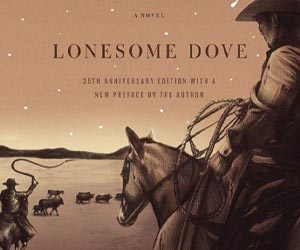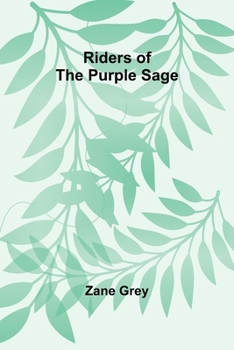Riders of the Purple Sage
(Book #1 in the Riders of the Purple Sage Series)
Select Format
Select Condition 
Book Overview
Riders of the Purple Sage, a classical book, has been considered essential throughout the human history, and so that this work is never forgotten we at Alpha Editions have made efforts in its preservation by republishing this book in a modern format for present and future generations. This whole book has been reformatted, retyped and designed. These books are not made of scanned copies of their original work and hence the text is clear and readable...
Format:Paperback
Language:English
ISBN:9357929231
ISBN13:9789357929233
Release Date:September 2023
Publisher:Alpha Edition
Length:256 Pages
Weight:0.84 lbs.
Dimensions:0.6" x 6.0" x 9.0"
Customer Reviews
6 ratings
The Best Western Ever
Published by Charles , 4 years ago
What can one say about "Riders of the Purple Sage"? For as long as man has dreamed of the west, he has written about it or sought it out for himself. Yes, James Fennimore Cooper wrote about the "west". There were the Dime Novels and the Penny Dreadfuls of the 1800's written by such as Ned Buntline. Then an Eastener named Owen Wister created a character called "The Virginian" and Zane Grey had already written "Heritage of the Desert" but "Riders of the Purple Sage" would immortalize both the author and the genre of "westerns". From then on every "western" would be compared to this one. The ironic part is: Zane Grey never considered them to be "westerns"; they were romances, romantic adventures, romantic novels. And to be totally accurate, the word, "western" did not exist at the time this book was written; it did not come into use until 1927 at the earliest, so to insist Zane Grey was a "western" writer is suspect, at best. But "Riders of the Purple Sage" has everything a person has come to know and understand that belongs in a story of the west--the taciturn gunfighter; the woman in distress fighting a losing battle; great scenery; fast horses; and evil men. Yet "Riders" is more than that. It has sub-plots upon sub-plots that keep the reader wondering what is going to happen next, and this book "fills the bill". And, what most people don't know or realize today, Zane Grey wrote quite often from a woman's viewpoint, and does so in this book. At the time of ZG's greatest popularity more than half of his readership were women, and he was published in such magazines as, Cosmopolitan, Colliers, and Ladies Home Journal. If you have never read a "western" I whole-heartedly urge you to try this one.
Riders of The Purple Sage
Published by Thriftbooks.com User , 16 years ago
I love Zane Grey and find his book so entertaining. I loved the story line
The Heoric and Romantic West: myth and adventure alive!
Published by Thriftbooks.com User , 16 years ago
The word Lassiter is a name synonymous with gunslinger, hard-edged men with no fear and little room for mercy and love. But when a particular Lassiter entangles himself in the lives of a small Mormon border village, among the purple sage wilderness of Utah, it is anything but slow or dull. The plot is very complex, blending romance and love, adventure, religion, mystery, suspense, hero mythology, rough and tumble adventure, introspection of man's frailty, and the blind and honest realizations that life, when the moment is right and with the right people, becomes more than it could have been. What Grey does is incredible, both describing the Utah canyons and sage fields with such vividness and detail; and weaving an intricate tale into an epic odyssey of three people, richly depicted and alive: Jane Withersteen, a devout and wealthy Mormon gradually comes to question the churchmen whom she put so much faith in, who are slowly and sneakily trying to break her by taking away everything she loves. Bern Venters, a young Gentile who is caste out, a hunted and marked man who sheds his youthful fervor when he shoots then saves the life of a young innocent girl, Bess. And then, there is Lassiter, a man haunted and wrath-filled by the disappearance of his sister and the loneliness of his trade, has roamed for over ten years to find out what became of her, arriving just in time to meet Jane and save the life of Venters. But when he meets Jane...everything changes. In fact, all gradually change, become so much more as each meet their opposite and struggle, their stories which are told with such care, it will make you heart pound and react TO THEM. It's wonderful! Have you ever read a book where you're shouting at the characters: 'Don't do that!' or 'Why can't believe him!?!'? Grey evokes imagery and emotion, drawing in the reader, forcing them to interact, react and feel as the characters do. While there is a strong negative representation on Mormanism, it is not the religion itself that is denounced (for Jane represents the goodness of the purity of faith--be it Mormanism or no) but the men who abuse that belief in order to control others. It is more about true belief in people and what it means to believe, for oneself, versus domination and subjugation of its followers and the harsh punishment of those who do not belong, i.e., the Gentiles. This is a concept that is universal, so please, please don't be offended or come into the story with bias. Remember: this book was written in 1912, and is both a reflection of the times, some history of the area and also, it is an extremely integral vehicle for the plot and an important impetus of change. Some one commented that the dialogue wasn't good. Heed this person's opinion with caution, please. While the vernacular and style can be distracting (at first), the words are magnetic and vivid, the character's own voice resonating in your head, and the meaning moving. In a way, the dialogue is Grey's own way of
Riders of rhe Purple Sage
Published by Thriftbooks.com User , 16 years ago
This is a real classic. I first read it as a teenager, now I'm 66 and enjoyed it just as much if not more.
Zane Grey's Legacy
Published by Thriftbooks.com User , 16 years ago
A master of the western genre, Zane Grey's trademark is his devotion to detail in both description and historical accuracy. When I read this novel, I felt as though I was there, riding alonside Lassiter--the classic gunslinger dressed in black--as he defends the spinster Jane Withersteen against efforts by unscrupulous men to take her ranch. Longer than the traditional western novel, this novel is the apex of Grey's work. A fascinating read (and ride). Thomas E. Hart Author of "Days of Vengeance" A western novel.
Classic western story
Published by Thriftbooks.com User , 18 years ago
This is the only western I've ever read; I'm mostly into classical literature, science writing, and non-fiction, but I asked friends for a book rec in the field, and they said read this one and the two Thomas Berger novels about Little Big Man. The novel is interesting in that it's not a stereotypical western story. The main character is a woman who owns a large cattle ranch and is basically the mainstay of the little town of Cottonwoods, a Mormon town on the Utah border, sort of like the Cartwright family was in the popular TV western series, only in this case, Lorne Green is replaced by a female lead. The novel also is unusual in that it shows her struggling against the tyranny and even criminality of her fellow Mormon ranchers, who don't like the fact of a beautiful, wealthy, but unattached woman, who wields considerable influence in the local town despite their best attempts to undermine her. One the things that sparked my interest in the novel was hearing an English prof in a radio interview on National Public Radio talk about some of the scholarship that is being devoted to genres like the western novel. She was working herself on the books of Karl May (The Legend of the Llano Estacado), Owen Wister (The Virgianian), and Zane Grey. One of the interesting things she had to say had to do with Grey's vivid prose descriptions of the western landscape. She said Grey's prose sensualized the landscape, giving it an almost masculine sensuality and almost sexuality. I'm about halfway into the book, and I can say that the rugged countryside of sheer, rock-walled canyons, arid plateaus and valleys, and wide-open spaces of this part of Utah are vividly described by Grey and serve, not just as a dramatic backdrop against which the novel's events take place, but as a palpable force for good or evil by itself. Contrary to some other reviews I've read that said the plot wandered a bit, I'm not really noticing that. I think the book has a strong plot with a lot of powerful elements going for it: interesting characters (including a dangerous and mysterious but chivalrous gunslinger), a sympathetic main character who struggles and triumphs against society's evils (not just a few western-style bad guys), beautiful and evocative descriptions of the landscape, and, as the backcover says it, "hairsbreadth escapes." One last interesting thing is that, if I remember correctly, Zane Grey was actually a Pennsylvania dentist who failed in his attempt to set up a profitable dental practice in New York. He wanted to get into writing westerns, and when his first novel was a big success, his writing career was launched and he never looked back. Riders of the Purple Sage is probably his most famous book, and despite it's not being a typical western novel, it has become a classic in its field.
Riders of the Purple Sage Mentions in Our Blog

Get Lost in the Wild West
Published by Ashly Moore Sheldon • June 05, 2019
Celebrate Larry McMurtry's 83rd birthday this week with one of these rip-roaring Western adventure tales.





